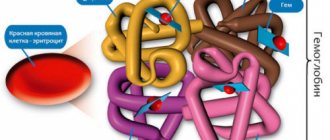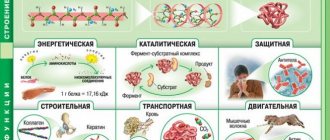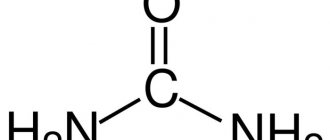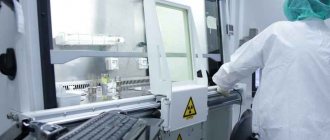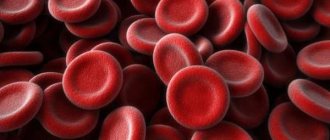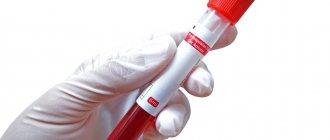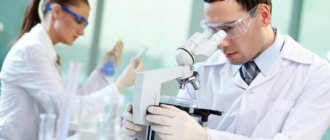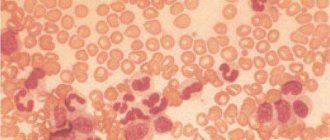© Author: Z. Nelly Vladimirovna, laboratory diagnostics doctor at the Research Institute of Transfusiology and Medical Biotechnology, especially for SosudInfo.ru (about the authors)
A blood test for vitamin B12 is an important biochemical test prescribed in cases of suspected deficiency. Vitamin B12, called antianemic or cyanocobalamin because of the cobalt (cobalamins) it contains, is a biologically active substance (BAS) very similar to porphyrins, quite complex in structure compared to other members of the group of vitamins. However, B12 and cyanocobalamin are not entirely synonymous; it’s just that in this form this substance arrives in the body to be absorbed there. The concept of “vitamin B12” is somewhat broader, because, in addition to cyanocobalamin, it includes other cobalt-containing biologically active substances: two coenzymes (methylcobalamin and 5-deoxyadenosylcobalamin, which has another, shorter name - cobamamide) and hydroxocobalamin. This means that not all substances called vitamin B12 can be called cyanocobalamin.
A blood test for vitamin B12 is prescribed according to indications; it is not included in routine biochemical tests. This test is used when symptoms of macrocytic anemia are present, as well as when there are clear signs of long-term malnutrition. In older people, analysis helps to find the cause of mental disorders.
In addition to people who have a natural pathology in this regard or a disease acquired during life, a blood test for vitamin B12 should be of interest to vegetarians and, especially, adherents of veganism - the strictest form of vegetarianism, those who completely reject food of animal origin, because they Providing the body with cyanocobalamin should be considered first.
Normal blood level B12
Readers who are interested in the blood level of this substance may encounter somewhat contradictory information. This is due to the fact that B12 levels can be measured in different units, and each laboratory has its own reference values. In this regard, when citing blood standards, we hasten to remind you that they are only approximate. How low the indicator is or, conversely, increased, should always be found out in the laboratory that performed the blood test for vitamin B12.
For example:
- Doctor of Medical Sciences, Professor of Laboratory Medicine V.S. Kamyshnikov gives the following indicators in his reference book: the norm in the blood of vitamin B12 is from 160 to 950 ng/l (nanograms per liter) or from 118 to 701 pmol/l (picomoles per liter) , defining the lower limit from 150 to 200 ng/l;
- Some laboratories, using the latest equipment from foreign companies (Switzerland) to analyze vitamin B12, give their reference values: from 190 to 663 pg/ml (picograms per milliliter);
- Based on the reference values of institutions that determine the active form of B12 (holotranscobalamin - holoTC) on American analyzers, the normal blood level for men from 18 to 69 years old will be 25.1 - 165.0 pmol/l. In women from 18 to 65 years old, this figure will vary within the same limits (25.1 – 165.0 pmol/l).
It is better for the patient himself not to try to convert the units; if necessary, this will be done by the laboratory diagnostics doctor. To avoid confusion, you should simply contact the laboratory for clarification.
However, before moving on to the next sections and telling when and under what circumstances a reduced level of cyanocobalamin is observed, when it is elevated in the body and what the consequences are, it would be useful to introduce readers to this substance more closely, to explain its biological properties and significance.
How to prepare for analysis
To obtain reliable results from a B12 blood test, you need to properly prepare for collecting the material. The picture of the normal level of a substance in the blood is influenced by many factors.
You must donate blood in the morning, observing the following requirements:
abstinence from alcohol 3 days before the test;
quit smoking 12 hours before the test;
refusal of physical activity the day before the analysis;
refusal to take medications with the doctor’s permission 2 days before blood sampling - when this is not possible, you should inform the laboratory in advance where the material will be tested;
refusal to eat 12 hours before the test.
Before submitting the material, you can drink only clean, still water. Any drinks are prohibited, as they significantly change the blood picture.
The material for research is taken from a vein. If no additional analysis is performed, then 5 ml of blood is enough.
This "special" vitamin
Cyanocobalamin is noticeably different from its “brothers”, having a certain uniqueness, which in terms of its chemical structure is that in all living nature only this vitamin has cobalt (metal) atoms that combine their electrons with carbon electrons, creating a covalent bond. In addition, cyanocobalamin is a vitamin that is associated exclusively with the animal world; it cannot be synthesized in products of plant origin. B12 is produced by intestinal bacteria and a special type of living anucleate microorganisms (archaea) that do not have organelles, live in the large intestine, are not pathogenic and are not parasites. However, you should not rely on your own resources, since it is not yet clear whether the vitamin produced by colon bacteria has the ability to be absorbed in the small intestine.
Obtaining vitamin B12 artificially for many years was considered an impossible task. But, as is known, the synthesis of this natural product was still able to be established. And the synthetic vitamin owes its birth to the outstanding American organic chemist, Nobel laureate Robert Burns Woodward, who presented to the scientific world in 1973 a multi-stage (almost 100 stages) scheme for the synthesis of the “capricious” vitamin. The scheme, which has become a classic, serves humanity to this day.
Its biological tasks
The biological significance of this natural product is indisputable:
- Cyanocobalamin ensures proper functioning of the bone marrow (erythropoiesis);
- The lack of this substance in organ tissues disrupts the production of macromolecules that encode and transmit genetic information (DNA and RNA);
- Its deficiency does not have the best effect on the quality of many biochemical reactions occurring in the body (for example, ethanol deaminase, glycerol dehydrogenase);
- Insufficient intake or poor absorption disrupts the production of methionine, which belongs to the group of essential amino acids;
- A lack of vitamin B12 will lead to a deficiency of folic acid in the cell (during the methylation reaction, it does not allow folic acid to penetrate the plasma membrane and leave the cell);
- A decrease in vitamin B12 in the blood disrupts the metabolism of glutamic acid, which is actively involved in nitrogen metabolism.
Vitamin B12 “does not like” free floating; 90 percent of it in plasma is associated with proteins.
Once it enters the body (in an inactive, non-digestible form), it finds intrinsic factor (ICF) in the stomach to bind to and activate. This means that under the influence of an enzyme produced by the gastric mucosa (Castle factor), it strives to acquire a form capable of absorption in the ileum, in the cells of which it must contact another protein - transport, and with it form a complex “transcobalamin + VitB12” " This biologically active complex is called holotranscobalamin (holoTC), only it is “familiar” with specific receptors in cells and, thanks to this, provides tissues with a component important for life - cobalamin. In addition to converting vitamin B12 into an active form, the intrinsic factor performs another important function: it serves as a kind of protection for cobalamin from bacteria living in the intestinal tract, which would “gladly” eat it in a free state. The portion of the active form of the vitamin present in the body is about 20%. The lion's share of this substance is in the form associated with another protein - R-protein, haptocorrin (holoHC), this complex does not show any activity, does not “know” specific receptors, except for those located in places of storage (liver tissue). The part of the “transcobalamin + VitB12” complex formed in the cells of the ileum, which is planned for storage, also arrives there, in the liver. The other portion of active vitamin B12 is sent to the spleen, kidneys, and muscle tissue for use. If necessary, cobalamin in haptocorrin will also come into play. It will break away from the R-peptide in the duodenum and combine with the Castle factor, that is, it will also acquire an active form.
The constant reserves of vitamin B12 in a healthy person range from 2 to 5 mg , and its metabolism is very sluggish; it cannot be called a mobile substance. This natural product in the body is characterized by enterohepatic (enterohepatic) circulation: together with bile from the liver, it goes to the intestine, where it is partially reabsorbed, that is, absorbed back, then, as part of the “transcobalamin + VitB12” complex, returns to the liver. Approximately half (approx. 50%) of the cobalamin present in the body is concentrated in the reserve (in the liver) and, thanks to the highly efficient enterohepatic (enterohepatic) circulation, it can retain it for quite a long time - up to 5 years.
Every day, to meet its needs, the body spends from 2 to 5 mcg (micrograms) of this substance, but only a tiny amount of 0.02 mcg is lost forever (in the urine).
A healthy person who receives a sufficient amount of this natural product need not be especially afraid of oversaturation. Excess, if it forms, will be taken up by the urinary system.
Why does a woman’s body need vitamin B12?
There is no vitamin in nature that, when introduced into the body, does not have an effect on humans. Every woman needs B12. The body can independently synthesize this component, but only in small quantities. For proper functioning of all organs, supplementation in the form of food or medicine is required.
Important! A woman's daily requirement of B12 increases during pregnancy.
This is explained by the fact that this component is required for the correct occurrence of various chemical reactions. The benefits of vitamin B12 for women are as follows:
- Creation of DNA links. If the concentration of this compound is insufficient, the process of information transfer between chromosomes suffers.
- The component is involved in brain development. Without B12, cells will not be able to divide, which will cause disruption of all body systems.
- To stimulate the synthesis of red blood cells, which are involved in the process of oxygen transport. When blood circulation is impaired, tissues do not receive enough energy.
- B12 protects liver cells from the effects of toxic substances. This includes drug components, alcoholic beverages, drugs and viruses. Also reduces the risk of gallstone formation.
- To protect the walls of vascular tissues, reducing the likelihood of blockage.
- B12 helps normalize the rhythm of the heart and also strengthens muscle tissue.
- The component stimulates the regeneration of bone marrow cells. The compound helps form osteoblasts. For women during menopause, B12 reduces the risk of fractures. This is explained by the fact that an insufficient number of osteoblasts provokes the formation of cavities in the bones.
- For women, the vitamin helps fight diseases of the musculoskeletal system.
- To eliminate allergy symptoms.
- The component enhances the protection of mucous membranes.
- Helps fight wrinkles, paleness and dry skin. Prevents the appearance of age spots.
We recommend reading: The best vitamins for women over 40: reviews, names, which ones to choose
The importance of every step of the way
Every day (with a balanced diet and good health) the body receives from 5 to 50 mcg of B12, to ensure normal life, ≈ 1.5 mcg remains, a little more than half of the incoming substance is excreted with feces, the excess that is not needed by the body is removed with urine. Of course, disorders at any stage of the path from the stomach to the ileum, as well as disorders of other systems associated with cobalamin, will interfere with complete absorption and contribute to the development of vitamin B12 deficiency, for example:
- Deficiency of internal factor - its cause may be atrophic gastritis (gastrogenic B12-avitaminosis - histamine-refractory achlorhydria: the production of hydrochloric acid stops, the mucous membrane atrophies, the synthesis of VF is absent). Atrophic gastritis is accompanied by the constant production of antibodies directed against the parietal cells of the stomach that synthesize VF, which leads to malignant anemia (pernicious or B12-deficiency anemia). In this regard, the development of this disease in older people is understandable - the acidity of gastric juice decreases, and then the functional activity of parietal cells is inhibited. Being not associated with VF, almost all of the vitamin received from food passes through the intestines in transit and is removed with feces. Of course, in such patients, a blood test for vitamin B12 will show a reduced level;
- Gastrogenic and enterogenic B12 vitamin deficiency develops with the removal of various parts of the gastrointestinal tract (especially the stomach, middle and lower third of the small intestine), Crohn's disease, which often affects the small intestine, celiac disease, in which the body does not tolerate gluten, congenital defects in the structure of the gastrointestinal tract, gastrointestinal tumors (syndrome malabsorption: inadequate absorption of all nutrients in the small intestine, including cyanocobalamin);
- Colonization of the gastrointestinal tract with competitors (helminths, bacteria), which also require cobalamin. The worst enemy for humans (in terms of competition) is the wide tapeworm, which lives in the small intestine and reaches several meters in length. Considerable harm to the process of assimilation of cyanocobalamin is caused by bacterial flora that actively reproduces and absorbs nutrients (for example, in case of cecal syndrome).
Meanwhile, it has been established that cobalamin deficiency does not develop suddenly or immediately. It will take about 6 years to create conditions in which low B12 levels are observed. However, even with good health initially, some people “manage” to reduce its content and achieve negative results exogenously, without receiving food that provides this important natural product. Most often, such problems plague vegetarians (especially vegans) and young girls who starve themselves in the pursuit of what they consider perfection (exogenous B12 vitamin deficiency). Sometimes exogenous deficiency develops in women during pregnancy, and mothers with many children who do not follow their diet suffer more often than others, whose body does not have time to replenish reserves from one pregnancy to another.
How dangerous is too much B12?
Due to the progression of hypervitaminosis, conditions develop that not only worsen health, but are life-threatening.
- An increase in the number of formed blood cells, which leads to blood thickening, the formation of lumps and a predisposition to blood clots.
- The absorption capacity of the gastric tract decreases.
- Vision deteriorates.
- Neuroses, mental disorders, even hallucinations appear.
- The functioning of the cardiac system is disrupted, and myocardial failure develops.
An overdose of synthetic B12 drugs can cause severe allergic reactions, including angioedema or anaphylactic shock, which has a high risk of death.
A lack of vitamin leads to anemia, a condition that requires immediate treatment. The progression of anemia leads to brain hypoxia and irreversible structural and functional disorders.
What happens after a critical loss of B12?
Gastrogenic cobalamin deficiency creates conditions for the development of pernicious anemia (pernicious anemia, pernicious anemia, Addison-Birmer disease, B12-deficiency anemia - these are synonyms for one disease), as well as certain types of megaloblastic anemia that occur against the background of another pathology.
With pernicious anemia, changes in the red blood are clearly expressed: huge sizes, with signs of degeneration, red blood cells (ugly macrocytes and megalocytes) are extremely saturated with red blood pigment (hyperchromia), as a rule, there is a reduced content of young red blood cells - reticulocytes.
As stated above, pernicious anemia prefers a mature or elderly age. The disease covers almost the entire body, involving other systems that will respond to low levels of cyanocobalamin in the blood:
- B12 deficiency leaves a significant impact on the activity of proliferating cells, thereby disrupting the functioning of the bone marrow, disrupting the division, differentiation, and maturation of erythroid cells (megaloblastic anemia);
- Lack of cyanocobalamin inhibits the functional activity of the immune system. Immunodeficiency is based on impaired maturation of white blood cells - neutrophils, which leads to a decrease in the bactericidal abilities of neutrophil leukocytes;
- The nervous system receives a painful blow. Damage to the spinal cord (sclerosis of the posterior and lateral spinal cords - funicular myelosis), caused by long-term profound deficiency of cobalamin, makes a person disabled. Due to the lack of this vitamin, intellectual abilities decrease, mental disorders of various kinds, and dementia are noted.
Of course, in such cases, in addition to oral compensation (food + pharmaceuticals), you will have to turn to the injectable form of cyanocobalamin. At one time, the ampoule with pink liquid, which is now in every hospital, has come a long way. The production of vitamin B12 has long been established - it is now produced on an industrial scale using microbiological synthesis with the participation of propionic acid bacteria, specially grown for the production of cyanocobalamin.
Low B12 and high levels in the blood
Based on the foregoing, a reduced level of cobalt-containing vitamin in the blood can be expected in the following cases:
- Development of pernicious (malignant) anemia;
- Searching for the cause of funicular myelosis;
- Far advanced anacid gastritis;
- Nutritional macrocytic anemia;
- Chronic pathology of the stomach, especially those occurring with atrophy of its mucosa;
- Conditions after surgery with removal of part of the stomach or intestines;
- Hereditary defects in the structure of the intestinal tract;
- Suspicion of a parasitic infection (presence of tapeworm in the intestines);
- Chronic lesions of the renal and hepatic parenchyma;
- Chronic abuse of alcohol-containing products;
- SPRU – a disease of unknown origin accompanied by persistent diarrhea;
- The appearance of signs of B12 vitamin starvation due to a long-term diet, targeted or forced (exogenous B12 vitamin deficiency).
Meanwhile, there are conditions when a blood test for vitamin B12 shows a fairly high result (although it is unlikely to be elevated in a healthy person). This occurs mainly with severe liver damage (in other cases against the background of other serious diseases). Thus, a high level will be observed when:
- Acute hepatitis of any origin, including viral hepatitis type A, which has a fecal-oral transmission route (vitamin content can increase up to 8 times);
- Liver cirrhosis (certain forms) and other chronic processes occurring in this organ and occurring with the destruction of its parenchyma;
- Hepatic coma (the level is not just high, but very high, it can deviate from the upper limit of normal by 40 times);
- Malignant liver tumor (hepatocellular carcinoma or liver cancer, as it is popularly called);
- Acute and chronic hematological pathology (monocytic leukemia, erythromyelosis, myeloid leukemia), when a 30-40-fold excess of the norm can be observed.
Of course, if this indicator is elevated, the patient is unlikely to wonder how to reduce it. In most cases, a sick person will rely on the qualifications of a doctor and think about how to get out of a serious condition. And the excess cyanocobalamin formed in the body during the pathological process, along with other treatment, will be dealt with by professionals.
Preparing for a blood test for vitamin B12 does not involve anything unusual. The patient prepares as for any biochemical study. The only thing that the laboratory assistant always remembers is that cyanocobalamin does not tolerate sunlight very well, so contact with ultraviolet radiation should be limited as much as possible. As for the analysis itself, there are some nuances. Determining total content does not give the full picture; more information can be obtained by studying the active form of vitamin B12. Currently, a new method for determining Castle's VF has been developed (the so-called Schilling test), but, unfortunately, the components necessary to perform the reaction are quite rare and expensive, so not every laboratory can afford such a luxury.
B12 sources
The main supplier of B12 is considered to be protein products of animal origin. Most B12 is found in veal liver, kidneys, octopus meat, mackerel, and rabbit meat. It is recommended to consume dairy products. Introduce cheeses into your diet. There is much less of this element in plants. Its maximum content is in algae (kelp or blue-green), brewer's yeast, tofu soy cheese and miso sauce.
There is also synthetic cyanocobalamin, created in laboratory conditions. Available in the form of tablets, capsules, ampoules (intravenous injections). It is used to replenish the body in case of a lack of substance. You should use a synthetic product after consulting your doctor.


